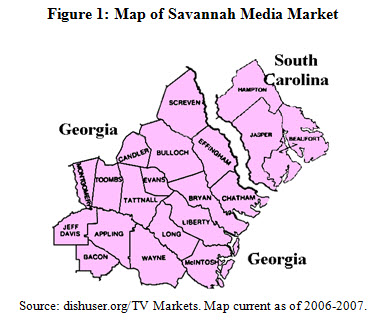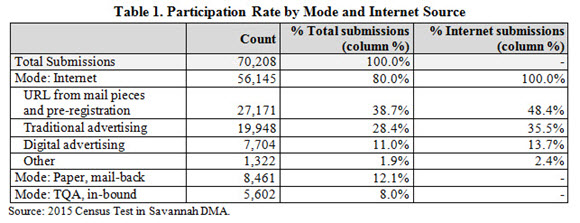Digital Advertising: Encouraging Participation in the Decennial Census
Digital Advertising: Encouraging Participation in the Decennial Census
The U.S. Census Bureau conducted a test of digital advertising and other communications techniques as part of the 2015 Census Test in the Savannah, Ga., test site. This test marks the first time the Census Bureau used communications and paid advertising to drive direct response through the online data collection instrument from visits to the web address prominently featured in advertising materials and through digital advertisements. Additionally, this was the first opportunity for some households to participate without receiving any mailing materials since the Census Bureau adopted the mailout/mailback approach in 1970.
The Census Bureau selected 120,000 households to receive mail materials as part of concurrent operational tests, yet all remaining households (approximately 320,000) were also eligible to respond. These households learned of the test via television and radio commercials, print advertisements and billboards, news stories, partnership events, social media, and digital and targeted digital advertisements. Digital advertising refers to online advertisements in any platform designed for mass consumption. Targeted digital advertising refers to paid digital advertising designed for consumption by and delivered to a specific audience based on demographics or other characteristics that utilizes tailored messaging, content and imagery.
Our research focused on the following hard-to-count groups with low internet usage and historically lower response rates to both the 10-year census and the annual American Community Survey:
- Young adults (ages 18-25)
- Seniors (ages 65+)
- Renters
- Low-income households
- African-Americans
- No high school education
- Parents/families with children
- Households with a female head
- Hispanics
The test produced many encouraging results (See Table 1). Eighty percent of respondents completed the test questionnaire via the internet. Of those submissions, nearly half (49.2 percent) are directly attributable to the advertising campaign. These respondents entered the online response instrument and completed the test by either typing in the advertising campaign URL (35.5 percent) or by clicking an advertisement online (13.7 percent).
Among households that received 2015 Census Test mailings, 69 percent of responders opted for online completion (See Table 2). The mailing materials contained a unique response URL, however, 16.4 percent of these respondents did not use that URL to access the online form, instead entering directly from digital advertisements, via partnership efforts or by visiting the advertising URL used for this test. Among households not selected to receive a mailing, nearly 24 percent responded after clicking on a digital ad, which is impressive given this was the first attempt to link respondents from a digital ad to the response site.
Accuracy of digital targeting (alignment between the respondent’s self-reported demographics and the targeted ad consumed) is also important (See Table 3). We were largely successful in this area especially for targeted ads aimed at seniors (88 percent accuracy), African-Americans (75.4 percent) and Hispanics (72.9 percent). However, we were less successful with young adults (48.9 percent) and with renters (45.5 percent).
Overall, the results from this advertising test show considerable promise for the use of digital and targeted digital advertising as a primary means to increase awareness about the 2020 Census, to motivate respondents to respond, to connect them directly to the online response instrument and to reach hard-to-count populations. It also validates the interaction between mailing strategies and traditional and digital advertising and its contribution to increases in self-response.







